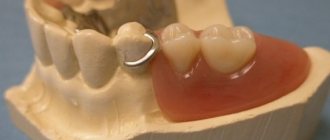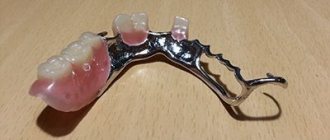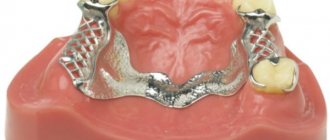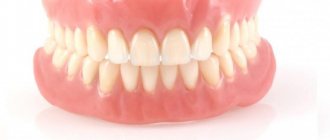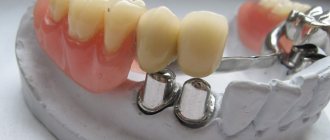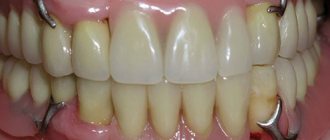From this article you will learn:
- what is a clasp dental prosthesis,
- its variants for the upper and lower jaw,
- types of fixation on abutment teeth,
- price of a clasp prosthesis for 2022.
Clasp denture is the best option for removable prosthetics, used only in cases of partial absence of teeth. This type of prosthesis gets its name from the German word “bugel,” which means “arch.” Accordingly, it will be distinguished from traditional dentures made of plastic or nylon by the presence of a metal frame, to which (in the area of missing teeth) a base with artificial teeth will be welded (Fig. 1).
The base is the part of the prosthesis in which the artificial teeth are located (it is made of acrylic plastic, less often - of nylon or Acry-free material). The metal frame gives additional strength to the structure, which allows you to significantly reduce the volume and thickness of the plastic base of the removable denture. This means - 1) the prosthesis will occupy less volume in the oral cavity, 2) you will quickly get used to it, 3) wearing the prosthesis will be more convenient and comfortable.
Clasp prosthesis for the lower jaw –
In Fig. 1-3 you can see what a clasp denture for the lower jaw might look like. The metal arch of such a prosthesis will always be located on the inner surface of the alveolar process of the lower jaw (slightly below the lingual surface of the lower anterior teeth). Unlike clasp dentures for the upper jaw, the design of which can have a huge number of options, the design of clasp dentures for the lower jaw is always the same.
How much does a clasp prosthesis cost?
The price of lower jaw prosthetics using a clasp design depends on the following factors:
- base and frame material;
- the number of teeth that need to be restored with a prosthesis;
- material for dental crowns.
The average price of a clasp prosthesis is from 32,000 rubles. The price, as a rule, already includes payment for the prosthesis itself, treatment planning, installation of the system, and check-ups with the dentist.
Clasp dentures are an inexpensive and accessible way to restore a smile with a long service life (more than 10 years).
Clasp denture for the upper jaw –
The clasp denture for the upper jaw will also have a metal arch, which can occupy an anterior, middle or posterior position on the hard palate, or be “ring-shaped”. In the latter case, the arc will be located along the perimeter of the hard palate, leaving its central part open. The position of the arch is of great importance for comfortable chewing, diction, and preservation of taste sensations. But the choice will depend not on your preferences, but on the clinical situation in the oral cavity.
For example, from – 1) the number and location of missing teeth, 2) the relief of the palate, more precisely, the severity of the torus and the height of the vault of the palate, 3) the severity of the patient’s gag reflex. In terms of comfort, the best option is the rear position of the arch, i.e. in the projection of the chewing group of teeth (not reaching 4-5 mm to the border of the hard and soft palate). In this case, the arc will not interfere with the tongue, diction will not suffer, the usual comfort when chewing food will remain, and the expression of taste sensations will not suffer.
Options for clasp dentures for the upper jaw –
Important differences between clasp dentures and other types of dentures:
But above we have not yet listed all the advantages - why patients love clasp dentures. The fact is that a clasp denture (better than all other types of removable dentures) will allow you to chew food painlessly and efficiently. This possibility is achieved through special systems for attaching the prosthesis to the supporting teeth - these can be support-retaining clasps, or special micro-locks (attachments), or so-called “telescopic crowns”.
The fact is that conventional dentures made of acrylic plastic transfer chewing pressure - not to the remaining teeth, but to the gums under the plastic base of the denture. This leads to pain when chewing, as well as accelerated atrophy of the bone tissue under the denture. A clasp prosthesis, due to clasps, attachments or telescopic crowns, is able to transfer most of the chewing pressure - precisely to the supporting teeth, and not to the tissue under the base of the prosthesis.
Procedure
The full scope of work usually takes about 8 weeks. Before prosthetics, it is necessary to cure diseased gums and fill teeth. The patient can choose the model of the clasp he likes from a photo or an introductory model, based on the recommendations of the orthopedist. When creating complex structures, implantation and other dental procedures, the final result can be seen in 4-6 months.
Manufacturing
Photo: Making a prosthesis
It takes one to two weeks to create a clasp. First, the specialist makes an impression from which the denture is reproduced. Next, a mock-up of the dentition is made based on the cast. In the case of teeth grinding, temporary crowns are placed during the production of the prosthesis. Then the frame is tried on. If it fits, then artificial teeth are selected based on the shade of the enamel. The finished base is coated with a protective composition.
Installation
Photo: Installation of the prosthesis
You can evaluate the functionality of artificial teeth already during the first fitting. Installation of the prosthesis is not difficult. If these are clasps, then they are fixed around the supporting teeth. If there are locks, the prosthesis is tightly adjusted, and then the mount is snapped into place.
Types of clasp dentures –
As we said above, any version of a removable clasp denture will have a metal frame. Most often, it is traditionally made from cobalt-chromium alloy (CCH), but it is also possible to use titanium, as well as alloys with precious metals. A titanium frame prosthesis is the most modern option. The use of titanium makes it possible to reduce the weight of the prosthesis by 2 times (compared to if the frame is made of CCS), and the lower weight will ensure not only comfort, but also quick adaptation to the prosthesis.
The base of the prosthesis (it is pink) can be traditionally made of acrylic plastic, or from slightly elastic materials “Acry-free” or nylon. But the most important differences in clasp dentures concern their method of fixation on the supporting teeth. There are 3 possible fixation systems for this type of prosthesis, each of which we will discuss in detail in this article.
- clasp denture with clasps,
- clasp prosthesis on attachments (micro-locks),
- clasp prosthesis on telescopic crowns.
How to care for your prosthesis
Clasp dentures require regular care to extend their service life. The dentist explains the wearing rules after installing the structure. There are 5 main recommendations for patients:
- undergo regular preventive examinations with a doctor once a year;
- reduce the presence of solid foods in the diet (crackers, seeds, cornflakes, etc.);
- thoroughly clean dentures and teeth after each meal or at least rinse your mouth;
- use not only a brush, but also a specialized mouthwash, dental floss, and it is best to clean dentures with an irrigator;
- Carefully clean the place where the dentures are fixed to avoid the accumulation of bacteria in the gaps.
These rules do not create inconvenience for everyday life, so most patients find dentures comfortable.
Clasp denture with clasps –
Clasp denture with clasp fixation is one of the most popular types of removable dentures among patients (Fig. 1-11). Clasps are the branches from the metal frame of the prosthesis that clasp the remaining supporting teeth from different sides, thereby ensuring reliable fixation of the prosthesis in the oral cavity. But clasps perform not only a holding function, but also a supporting one.
This means that they ensure the distribution of the chewing load in such a way that it is transferred from the prosthesis not only to the gums, but also to the supporting teeth. As a result, approximately 1/3 of the chewing load of the clasp is transferred from the prosthesis to the supporting teeth, and the remaining 2/3 of the load is distributed from the base of the prosthesis to the gums. But with dentures made of plastic or nylon, the entire chewing load goes only to the gums - which is why pain occurs when chewing food.
Clasp denture with clasps: photo
As you already understood, clasps are in most cases made of metal, and that is why this type of clasp prosthesis has one big disadvantage. The fact is that metal clasps will be clearly visible if they fall into the smile line (Fig. 10). Of course, in some situations, the dental technician can place the clasps on the denture in such a way that they do not fall into the smile line, but, unfortunately, this is not always possible for every patient.
Some way out of this situation may be to replace the retaining metal clasps that fall into the smile line with nylon ones. These clasps can be given any color (white or pink), and they are almost invisible when you smile. But it is also impossible to make all the clasps of the prosthesis only from nylon, because... nylon has high elasticity, which means the prosthesis will be less secure in the oral cavity.
Clasp prosthesis with clasps: video 1-2
Alternative options
Most orthopedists consider clasp dentures to be the optimal way to restore dentition. But at the request of the patient or existing indications, an alternative may be offered.
Nylon constructions or Acry-Free dentures:
Conditionally removable dentures fixed on several implants:
Clasp prosthesis on attachments –
Clasp prosthesis with attachments (micro-locks) is one of the most advanced types of removable prosthetics. Such dentures provide the most reliable fixation on the teeth, correct articulation of speech, effective and comfortable chewing, as well as excellent aesthetics. The disadvantages include the high cost, as well as the need to take several teeth under metal-ceramic crowns (24stoma.ru).
Each micro-lock consists of 2 parts - one part is mounted on the body of the clasp prosthesis, the second - on metal-ceramic crowns closest to the prosthesis. When the parts of the micro-lock are connected, it snaps into place and can only be opened using a special movement or device. Attachments differ in their operating principle - they can be rail-shaped, spherical, crossbar, etc. In each specific clinical case, the orthopedic doctor, together with the dental technician, selects the most appropriate type of attachment for this patient.
One-sided clasp denture with micro-lock –
Double-sided clasp prosthesis with micro-locks –
Prosthesis with micro-locks for the upper jaw –
The big advantage of having micro-locks is - 1) unlike clasps, micro-locks are completely invisible when smiling, which provides good aesthetics, 2) very comfortable chewing of food, 3) excellent fixation of the prosthesis on the teeth. For example, such a prosthesis will be securely held on the teeth - even with terminal defects in the dentition (Fig. 15-16), i.e. when all other types of prostheses will simply fall off.
Important: once again, please note that with this type of prosthetics, several teeth are necessarily placed under metal-ceramic crowns. The latter are necessary because half of the micro-lock mechanisms are fixed in them. For example, to fix a double-sided clasp prosthesis, you will need 2 micro-locks and, accordingly, 2 metal-ceramic crowns “soldered” to each other on each side of the dentition. This number of crowns is necessary to avoid overloading the supporting teeth, to which chewing pressure will be transferred from the prosthesis.
For a one-sided end prosthesis, only 1 micro-lock is needed (Fig. 12-13). The chewing load is distributed during locking prosthetics as follows - approximately 1/2 of the load goes to the gums, and the remaining 1/2 is distributed over the supporting teeth (taken under metal-ceramic crowns). Given this load distribution, chewing with a denture with attachments will be even more comfortable than with a denture with clasp fixation.
Clasp prosthesis with attachments: video 3
Types of micro-locks in clasp dentures –
The best types of micro-locks are “MK-1” and “Bredent” (made in Germany), but there are also a large number of cheaper, but less reliable analogues. It is preferable to make MK-1, although they are even more expensive than Bredent. However, MK-1 locks are deadbolt type locks, and therefore they cannot be used in all clinical situations in the oral cavity. In turn, Bredent are micro-locks of the friction type (they use friction force).
Indications and contraindications for installation
The possibility of installing a clasp is determined during a dental examination. Removable dentures are used in the following cases:
- some molars are missing;
- it is necessary to hide multiple dental defects;
- The patient has been diagnosed with diabetes mellitus and periodontal disease;
- prominent maxillary cusps;
- flat sky;
- pathological weakness of gum capillaries;
- broken bite;
- atrophy of the alveolar processes;
- there is no possibility to install a fixed prosthesis, for example, due to severe inclination of the teeth;
- bruxism (teeth grinding);
- enamel wear is observed;
- it is necessary to restore the aesthetics of the anterior dentition.
The peculiarities of the clasps do not allow them to be installed on damaged abutment teeth affected by caries. There are other contraindications:
- small lingual-buccal space;
- inflammatory process in the area of the roots of supporting teeth;
- periodontitis;
- Lowered crowns were previously installed.
Clasp prosthesis on telescopic crowns –
This is the best option for clasp dentures, even in comparison with dentures on attachments (provided there is a sufficient number of teeth taken under telescopic crowns). This version of the clasp denture allows you to get the best aesthetics and comfort when chewing food. With this type of prosthetics, the prosthesis is fixed using special telescopic crowns.
Telescopic crowns consist of 2 parts:
- the lower part - metal caps that are fixed on teeth ground for crowns,
- the upper part - the crowns themselves, which are connected to the metal frame of the clasp prosthesis.
Thus, fixation of the clasp prosthesis is carried out due to the fact that the upper parts of the telescopic crowns are put on the lower ones. It should be noted that this type of prosthetics is not used often enough in Russia due to its complexity (the highest precision in the manufacture of caps and the metal frame of the prosthesis is required), and this is associated with its high cost. This version of clasp dentures usually costs no less, or even more, than clasp dentures with micro-locks.
Clasp prosthesis on telescopic crowns: photo
Varieties
Clasps are made from plastics, ceramics, and metal alloys. Gold-platinum structures are considered the most expensive. The products differ not only in composition, but also in the method of fixation. For the upper jaw use:
- Photo: Fastening - clasps
Clasps look like hooks. They are part of a cast frame and firmly hold the prosthesis even under intense chewing loads. They can be conspicuous, and therefore their installation is not always advisable;
- Photo: Fastening - locks
Locks - make the structure more attractive in appearance. They are hidden from the eyes of others, but it will be difficult to install them if the supporting teeth are low. Characterized by more rigid fixation and long service life;
- Photo: Telescopic clasps
Telescopic clasps - allow you to restore one tooth or an entire row. They consist of two parts: the lower one is installed on the support row, the upper one – on the frame. When connecting the elements, the structure is securely fixed. The most successful solution for the upper jaw;
- Photo: splinting mount
Splinting fastening - this type of clasp is more suitable for treatment. It reduces the mobility of weakened teeth and evenly distributes the load. It looks like a solid arc with a number of links.
There are also one-sided and two-sided designs. If everything is clear with bilateral ones, then the first ones are intended to correct the bite, restore single teeth and the aesthetic appeal of one part of the upper jaw.
Splinting clasp prosthesis –
It should be noted that the clasp denture (in addition to restoring chewing efficiency) can be given other functions in parallel. For example, we are talking about splinting mobile teeth in case of periodontitis. A splinting clasp prosthesis will have a thin metal arch on the inside (curved to the shape of the teeth), which will tightly wrap around the necks of the teeth (Fig. 20-21).
This arch helps reduce the mobility of the front teeth and stabilize them. However, there is an alternative opinion that the removal of such a splinting prosthesis from the oral cavity, as well as the process of fixing it on the teeth, is accompanied by too much pressure from the metal arch on the weakened front teeth, which, on the contrary, can lead to loosening of the teeth.
Splinting clasp prosthesis: photo
Clasp prosthesis: price in Moscow and regions
Clasp denture is the most popular type of denture for partial absence of teeth. You can read more about reviews of this type of prosthetics in the article: “Reviews of clasp prosthesis.” Now let's figure out how much a clasp prosthesis costs in clinics for 2022 (in economy class and mid-price clinics).
- Clasp prosthesis with clasps - the cost of a simple clasp prosthesis with clasp fixation in Moscow will be from 40,000 rubles, and in Russian regions the price will be from 35,000 rubles. The cost of a complex clasp prosthesis with clasp fixation (in the presence of a complex branched system of clasps), as well as a splinting clasp prosthesis in Moscow will be from 45,000 to 50,000 rubles.
- Clasp prosthesis on telescopic crowns - the cost of such a prosthesis starts from 75,000 rubles, and on average can be about 90,000 rubles. Typically, the required number of telescopic crowns is already included in this price, but some clinics may not include the cost of manufacturing metal caps in the cost of the prosthesis. This needs to be clarified during the consultation.
- Clasp prosthesis with attachments (micro-locks) - a prosthesis using inexpensive economy-class micro-locks will cost in Moscow - from 70,000 rubles, and for the regions from 65,000 rubles.
However, if prosthetics are performed using expensive micro-locks such as Bredent, the cost will be approximately another 20,000 rubles higher. It should be taken into account that the above prices already include the cost of the prosthesis itself, the cost of micro-locks, but does not include the cost of metal-ceramic crowns and preparation of teeth for prosthetics. The price for a one-sided clasp prosthesis will be about 50,000 rubles. This type of prosthesis is made for a unilateral defect in the dentition. This includes the cost of the prosthesis and micro-lock, but does not include metal-ceramic crowns.
Clasp dentures on a titanium frame –
All the above prices are typical for clasp dentures, the metal frame of which is made of cobalt-chromium alloy (CHS). We have already said that titanium is 2 times lighter than KHS, and also up to 5 times stronger. In addition, titanium has much greater tissue biocompatibility and a much lower risk of allergic reactions to metals. But prostheses with a titanium frame are much more expensive.
The cost of the simplest clasp prosthesis with clasp fixation (no more than 2 clasps) will be at least 50,000 rubles. In turn, the price for clasp prostheses made of titanium, which have a complex design, can range from 60,000 to 110,000 rubles. We hope that our article was useful to you!
Sources:
1. Personal experience as a dentist, 2. “Orthopedic dentistry. Textbook" (Trezubov V.N.), 3. National Library of Medicine (USA), 4. "Removable dentures: a textbook" (Mironova M.L.), 5. "Teeth restoration with clasp dentures (Fadeev R.A.) .
Contraindications
To install an orthopedic structure, support teeth are required, to which hooks are attached. That is, if you are completely edentulous, the clasp cannot be used. You can use the implantation service. Artificial teeth will securely hold the clasp denture with clasps, while restoring natural metabolic processes in the bone, preventing tissue atrophy.
The supporting teeth must be healthy and strong. They take on the burden of holding and chewing.
If you are allergic to metal, an orthopedic dentist may suggest a metal-free clasp prosthesis. If you are sensitive to other materials of the product, you should consult an allergist and choose with your doctor the best option for prosthetics or implantation.



